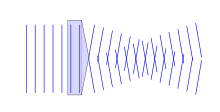Axicon

An axicon is a special, conically ground lens . An axicon maps a point source onto a line along the optical axis, or transforms a laser beam into a ring.
General
Axicons are conical lenses that generate a ring-shaped beam profile and are used in scientific research or in various laser applications. They can be both convex and concave and made of any optical material. By combining it with other axicons or lenses, a wide variety of beam profiles can be generated. The beam profile generated by an axicon is a locally limited Bessel-like beam , which arises as a result of the interference of all partial beams along the optical axis. Consequently, it has “self-healing” properties and a narrow main maximum.
Special features and Bessel beam shaping
Individual axicons are usually used to generate a ring-shaped light distribution which is laterally constant along the optical axis over a certain area. This peculiarity results from the generation of (non-diffractive) Bessel-like rays with properties mainly determined by the axicon angle α.
There are therefore two areas of interest for a large number of applications: a long area with an almost constant intensity distribution (a) and an annular far-field intensity distribution (b). The distance (a) depends on the angle α of the axicon and the diameter (Ø EP ) of the incident beam. The diameter of the ring-shaped far-field intensity distribution (b) is proportional to the length l. The ring width is about half the diameter of the incident beam.
application areas
Axicons are used in scientific research and in various laser applications that require a ring-shaped beam profile that has an almost identical distribution over a certain area along the optical axis.
Another application of axicons is in telescopes , in which the commonly used spherical lens is replaced by an axicon. Such a telescope can simultaneously focus on targets at distances of one meter to infinity without having to make adjustments.
Axicons can also be used in laser eye surgery. The ability to focus a laser beam in a ring-shaped beam profile is useful for smoothing and removing corneal tissue. By combining a convex and a concave axicon, as well as varying the distance from one another, the diameter of the ring can be adjusted for optimal power distribution.
Other uses
- Laser material processing
- Measurement and alignment applications
- Research & Science
Individual evidence
- ↑ a b JOHN H. MCLEOD: The axicon: A New Type of Optical Element . In: Journal of the Optical Society of America . 44, No. 8, 1954, p. 592. ISSN 0030-3941 . doi : 10.1364 / JOSA.44.000592 .
- ^ V. Garcés-Chávez, D. McGloin, H. Melville, W. Sibbett and K. Dholakia: Simultaneous micromanipulation in multiple planes using a self-reconstructing light beam Archived from the original on September 19, 2006. In: Nature . 419, No. 6903, 2002, pp. 145-7. doi : 10.1038 / nature01007 . PMID 12226659 .
- ↑ K. Dholakia, D. McGloin and V. Garcés-Chávez: Optical micromanipulating using a self-reconstructing light beam . 2002.
- ↑ Beam shaping using axicons - fields of application. asphericon GmbH, April 26, 2017, accessed on August 14, 2017 (German, English).
- ^ John H. McLeod: The Axicon: A New Type of Optical Element . In: JOSA . tape 44 , no. 8 , August 1, 1954, p. 592–597 , doi : 10.1364 / josa.44.000592 ( osapublishing.org [accessed August 14, 2017]).
- ^ Haw, Weldon W., MD, and Edward E. Manche, MD .: Prospective Study of Photorefractive Keratectomy for Hyperopia Using an Axicon Lens and Erodible Mask. In: Journal of Refractive Surgery . tape 16 , no. 6 , November 1, 2000, pp. 724-30 .